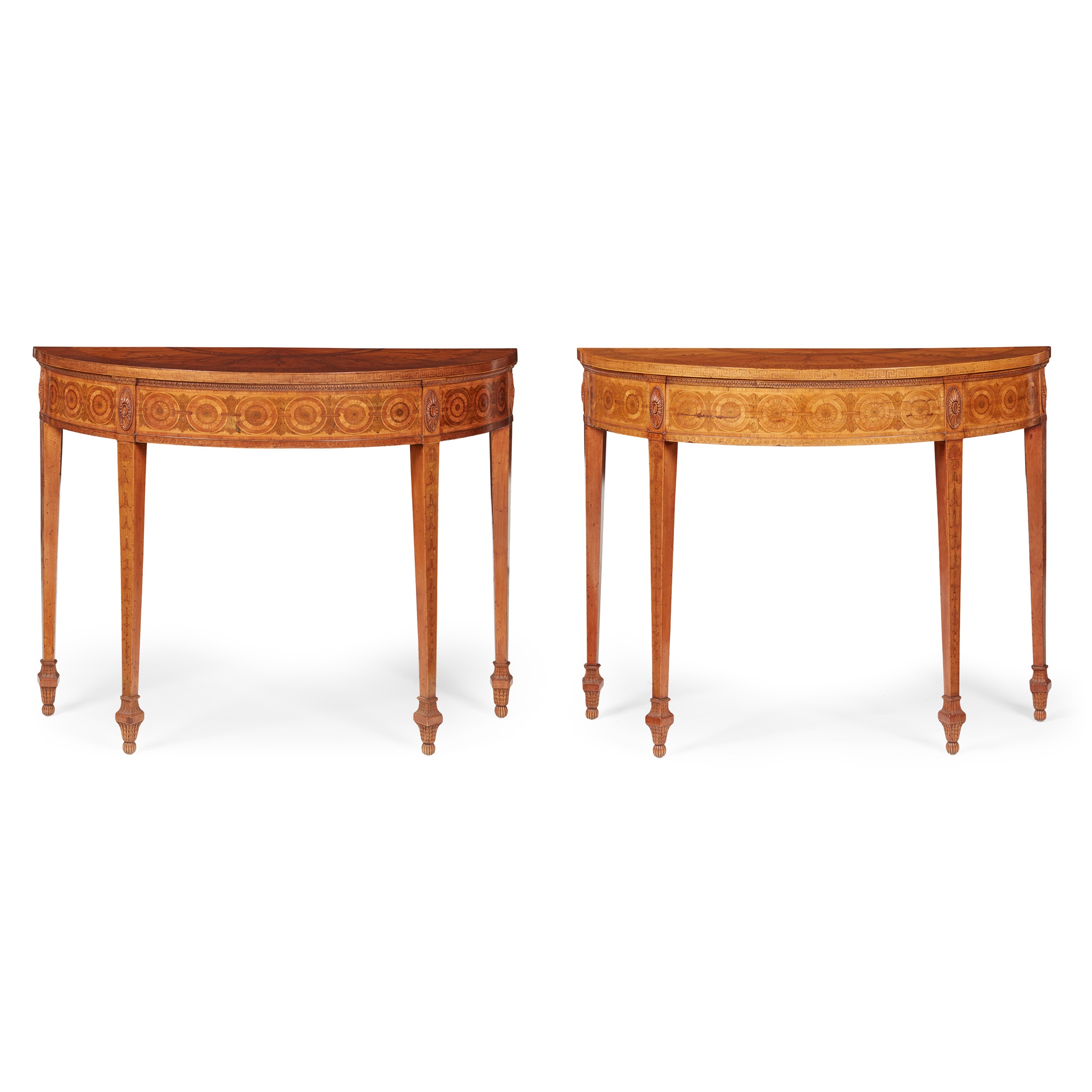PAIR OF GEORGE III SATINWOOD AND MARQUETRY DEMILUNE CONSOLE TABLES, ATTRIBUTED TO THOMAS CHIPPENDALE ◆
CIRCA 1760
£75,000
Auction: Day One: 18 May 2022 | From 11:00
Description
the semi-elliptical tops inlaid with fan medallions and wide bands of leaves and anthemion, enclosed by narrow borders of anthemion and leaves separated by inlaid dot banding, the edges in Greek key, above friezes inlaid with conjoined floral paterae between carved leaf tip moulding and Vitruvian scroll inlay, raised on slender square tapering legs headed by carved elliptical paterae and inlaid with pendant husk trails ending in crisp laurel leaf carved square toupie feet
Dimensions
115cm wide, 91cm high, 48cm high
Provenance
Provenance:
Purchased Arthur S. Vernay, Inc., New York, 1920s
The Collection of Mrs. John Rovensky, sold Sotheby's New York, 26 January 1957, lot 632
Sotheby's London, 3 June 1977, lot 137, where purchased by the vendor's family and thence by descent
Footnote
Note:
This pair of demilune console tables with their fine inlay and marquetry details demonstrate the Neoclassical influence gaining in popularity in the second half of the 18th century. While deceptively simple in appearance, they are of exceptional quality and workmanship. Utilising a design vocabulary based on Greek and Roman antiquity, they eschew the extravagant excesses of the Rococo. Gone are the curvilinear outlines and scrolling embellishments, replaced with ordered repetition and symmetry. The tables bear design similarities to the famed library table by Thomas Chippendale, made for Harewood House, and commissioned by Edwin Lascelles, 1st Baron Harewood, and now in the collection at Temple Newsam. What is most directly related is the marquetry design of the frieze, with its repeat pattern of linked paterae, interspersed with further elliptical carved paterae. In the Parke-Bernet Rovensky sale catalogue of 1957, the tables are listed as ‘parcel-gilded’, however there is no mention of gilding when they re-emerge for sale at Sotheby’s, London, twenty years later. An examination of the black and white image from the 1957 catalogue shows what appears to be gilding on the carved feet and the carved paterae heading the legs. When the tables appeared at Sotheby’s in 1977, they were then attributed to Chippendale, an attribution that remains today.
The New York socialite and heiress Mrs. Mae Manwaring Plant Hayward Rovensky [née Caldwell] was married four times, and was one of the richest women in the United States, with homes in New York City; Newport, Rhode Island; Palm Beach, Florida; Hartford, Connecticut; and Groton, New York. A woman of considerable charm, wit, and beauty, she famously persuaded her second husband Morton F. Plant, to negotiate the sale of their lavish Italian Renaissance Revival mansion on East 52nd Street and Fifth Avenue with Pierre Cartier for a rare double strand of one hundred and twenty-eight natural pearls. Maisie, as she was called, and Morton moved to their new, larger Italian Renaissance Revival mansion on East 89th Street and Fifth Avenue, and Cartier turned the 52nd Street mansion into the Cartier New York headquarters and showroom, which it remains to this day.
As well as a lover of fine jewels, Mrs. Rovensky was a collector of the fine and decorative arts, and would have been well-known to all the top New York dealers. When she died in 1956, Parke-Bernet conducted the sale of her estate over two weeks in January 1957, with specialist catalogues dedicated to paintings, jewellery, silver, furniture, porcelain, and works of art. The news of her death, and the auction of her estate, was covered in Time magazine, in a story entitled "At The End Of An Avenue".
The present pair of tables were offered in Part Two of the sale, which included the contents of Clarendon Court, Newport, and the final portion of the collection from 1051 Fifth Avenue, New York. Sold as lot 632, they are listed in the sale catalogue as a pair of ‘Hepplewhite’ demilune consoles, having been purchased from Arthur S. Vernay, Inc. New York. Based on the order of the sale and catalogue notes, it is believed the tables came from the Fifth Avenue mansion.
Arthur Stannard Vernay (1877-1960) was one of the most successful and influential dealers in English antiques in the United States in the first decades of the 20th century. An Englishman, Vernay was born Arthur Avant but changed his name and came to America as a young man in 1904. By 1906 he had opened his first shop in New York City, called Arthur S. Vernay, Inc. on East 45th Street, near Madison Avenue. From the 1920s he had moved premises to East 54th Street, as well as having a shop in London at 217 Piccadilly, and a summer shop in Newport, Rhode Island. Catering to an elite clientele of New York clients, his roster of customers reads like a who’s who of early 20th century society with names like Vanderbilt, Guggenheim, and Morgan among others. Vernay retired from his eponymous antiques business in 1942, but it continued to operate, undergoing a name change in 1978 to Vernay & Jussel, and continued until 1994, when it ceased trading. Vernay’s extensive sales archives are in the Winterthur library.
Literature:
Gilbert, Christopher The Life and Work of Thomas Chippendale, pp. 201-2, 215
Mauchline, Mary Harewood House, One of the Treasure Houses of Britain, pp. 86-103
Vernay, Arthur Stannard Decorations and English Interiors, 1927

